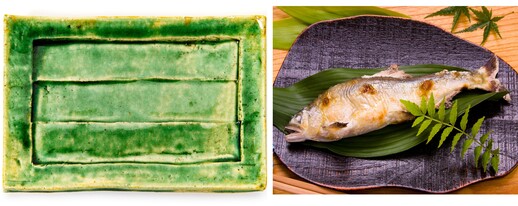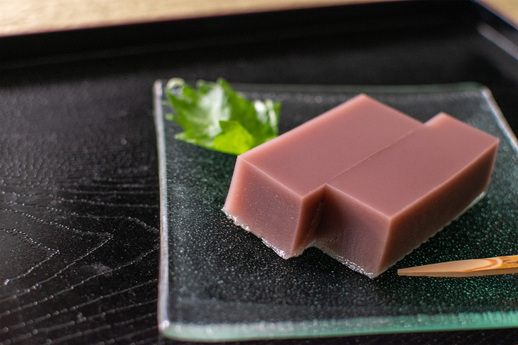2024.07.04
伝検通信(メルマガ)週刊メールマガジン「伝検通信」 第14号
週刊メールマガジン「伝検通信」第14号をお届けします。
今号のトップ記事は、宙ちゃんの「伝統文化一直線」 第8回 「丸くない食器」です。
「クイズで肩慣らし」は前回クイズの答え・解説と、茶道・和菓子・日本茶分野から出題します。
今月末までにメルマガ登録した方の中から、抽選で100人に公式テキスト(https://bookpub.jiji.com/book/b648563.html)をプレゼントするキャンペーンも引き続き実施中です!お近くの友人やご家族にぜひご案内ください。
目次
・ 宙ちゃんの「伝統文化一直線」 第8回 丸くない食器
・ 「クイズで肩慣らし」第14回(茶道・和菓子・日本茶)=「水羊羹」
・ 伝検協会だより
宙ちゃんの「伝統文化一直線」 第8回 丸くない食器
近藤宙時=日本伝統文化検定協会理事

日本独特の丸くない皿(左は織部焼)
鮎(あゆ)の塩焼きがおいしい時期になりましたが、鮎に限らず、焼き魚を食卓に出すと言うと、大抵の人は長方形の皿に盛り付けたものを思い浮かべるのではないでしょうか。
しかしながら、日本では当たり前の長方形の皿は、世界的に見るとかなり珍しい食器です。日本以外の国で丸い形以外の食器を見ることはまずありません。私が知っている限りでは、メキシコで魚形の皿が作られています。ただし、これは鑑賞用の土産品で、使われるとしてもせいぜいアクセサリー入れか何かで、食卓に乗ることはまずないと思います。
ところが日本では、焼き魚用の長方形の皿だけではなく、おひたしなどの向付に使う割れ山椒(サンショウの実が割れたような三つに裂けた形の小鉢)や菊形の銘々皿など、多くの家庭の食器棚に丸くない食器がごく普通に並んでいます。
どうして日本人だけが丸くない食器を使うのだろう。そんな疑問を抱いて縄文時代初期の隆帯文(りゅうたいもん)土器から歴史をたどると、豊臣、徳川と二つの政権で茶頭(さどう)を務めた古田織部(ふるた・おりべ)という戦国大名に行き当たります。彼がプロデュースした「織部焼」と称される茶碗は、それまでの常識を覆すものでした。何せ最初から形がゆがんでいるのですから。
古来、陶磁器職人は、いかに真円の食器を作れるかが腕の見せどころでした。そのための道具が轆轤(ろくろ)です。職人たちは轆轤をうまく使って真円の茶碗を作る修業を重ねました。ところが織部は、素焼き前のまだ粘土が柔らかいうちにグシャっと手でつぶしたような、真円とは程遠い茶碗を良しとしたのです。しかも、わざとらしくゆがめてはいけない。あたかも自然が生み出したような、作為の感じられないゆがみ方を求めました。これは実に革命的なことでした。
さらに織部は、ゆがんだ器に〇(丸)や□(四角)などの抽象的な図柄を描かせました。これによって、日本の食器は形からも図柄からも自由になったのだと思います。尾形光琳(こうりん)、乾山(けんざん)の兄弟は、織部が無作為の作為でねじ曲げたことで形の自由を得た食器を正方形や菊形、扇形などに美しく整え、そこに名画を描いてみせました。これで、日本の食器は世界で最も自由な食器になりました。
日本にしかない丸くない食器は、いずれ必ず世界を魅了するのではないかと夢見ています。そういう話をすると、「丸くない食器は海外では決して売れないよ、使わないんだから」と断言する人が少なくありません。靴を履かない未開社会の人たちを見て「靴は売れない」と諦めるのか、それとも「巨大な潜在需要がある」と心を躍らせるのか。その違いだとは思いますが、私自身は、世界中の人々が日本の丸くない食器を使う日が来るのを確信しています。
「クイズで肩慣らし」第14回(茶道・和菓子・日本茶)=「水羊羹」
~伝検公式テキスト(9月20日先行発売予定)のジャンルごとに出題します~

水羊羹
第14回
問題:代表的な夏の涼菓子の一つで、みずみずしく喉越しがよい食感の「水羊羹(みずようかん)」。古くから冬に水羊羹を食べる習慣があり、冬の風物詩として親しまれている県はどこでしょう。
【前回の答えと解説】
問題:日本城郭協会は2006年に「日本100名城」を選定しましたが、現在残っている天守の多くは戦後(1945年以降)に建てられたものです。江戸時代以前に建てられ、現代まで残っている「現存天守」は、いくつあるでしょう。
答え:12
解説:全国で一般的に見学できる城は現在、約200ありますが、戦後に再建されたものも多く、江戸時代以前に建設された「現存天守」はわずかに12城。このうち、長野県「松本城」、愛知県「犬山城」、滋賀県「彦根城」、兵庫県「姫路城」、島根県「松江城」の5城は国宝、青森県「弘前城」、福井県「丸岡城」、岡山県「備中松山城」、香川県「丸亀城」、愛媛県「松山城」「宇和島城」、高知県「高知城」の7城は重要文化財に指定されています。
伝検協会だより
東京・日本橋の三井記念美術館(https://www.mitsui-museum.jp/)に、第1回伝検(11月29日~来年1月31日)の案内チラシを置いていただきました。この場を借りて感謝申し上げます。同館は安土桃山時代の志野茶碗「銘卯花墻」(めいうのはながき)など国宝6点、重要文化財75点をはじめ、三井家が江戸時代から収集した美術品を約4000点所蔵しており、7月2日から9月1日までは「五感であじわう日本の美術」展を開催しています。
第1回伝検の案内チラシはこちら。
https://denken-test.jp/wp-content/uploads/2024/06/flyer_20240618.pdf
編集後記
伝検通信第14号をお届けしました。じめじめとした梅雨が続く季節、「クイズで肩慣らし」を読んでいたら水羊羹が食べたくなりました。竹に入った羊羹やフルーツ羊羹、ぷちっと楊枝で穴をあけるとみずみずしく出てくる北海道銘菓のまりも羊羹など、あれこれ思い浮かびます。全国の和菓子が取り揃えられている銀座三越に寄って帰ります。
カテゴリー: 伝検通信(メルマガ)





